Family : Mustelidae

Text © Prof. Giorgio Venturini

English translation by Mario Beltramini
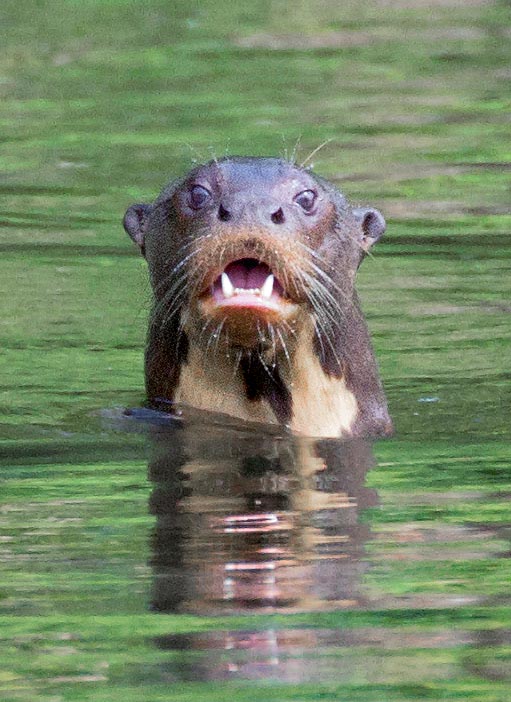
The imposing Giant otter (Pteronura brasiliensis) once lived most of the fresh water streams of South America, from Venezuela to Argentina © Giorgio Venturini
The first explorers of the Amazonian rivers related of noisy groups of otters that surrounded their canoes, ostensibly without any fear, and gave us the first descriptions about the social behaviour of this species. This big animal, gregarious, diurnal and of simple approach became an easy prey for the hunters attracted by the beauty of the fur.
Since the middle of the XX century, due to the strong commercial request, the fur trappers have decimated most of the populations, so much that today the species is included among the endangered ones in the Mammal Red Data Book (IUCN, World Conservation Union). The few surviving populations are menaced by the exploitation of the basins of the Amazon River, of Orinoco and of the Rio de la Plata, where the deforestation, the mining and hydroelectric exploitation and the oil prospection are rapidly degrading or destroying their habitat.
In spite of the vulnerability of the species the knowledge on its biology and its ecology are still nowadays poor and this renders problematic any conservation work.
Systematically speaking, the giant otter belongs to the order Carnivora, family Mustelidae and to the subfamily Lutrinae. The name Pteronura brasiliensis presently ascribed to Gmelin 1788 has been actually coined by Zimmermann already in 1780.
It has been proposed the subdivision of two subspecies, Pteronura brasiliensis brasiliensis and Pteronura brasiliensis paraguensis (or paranensis), not accepted by all authors.
The subfamily Lutrinae has been subdivided in tribes by some authors. According to this point of view our species should belong to the tribe Aonychini. The name Pteronura comes from the Greek pteron (πτερον), wing, and ura (ουρά), tail, hence, “wing-shaped tail”; brasiliensis, Latin, in reference to the geographic distribution.
Common names: lontra gigante in Italian; ariranha in Portuguese; perro de agua, lobo de rio, lobito de cola ancha, lobo gargantilla or nutria gigante (the term nutria may give rise to confusion because in Italian and in many not speaking Spanish countries it usually refers to a rodent: the Coypu (Myocastor coypus).
Zoogeography
Before almost reaching the extinction due to the furs trade (forbidden since 1973), the giant otter was common in all tropical fluvial basins of South America and east to Andes. Nowadays, become rare, is practically absent in all central Amazonia and survives in small separate communities at the margins of its original range. The total population is estimated in few thousands of specimens confined in restricted areas of Surinam, Guyana and French Guyana, Venezuela, Colombia, Ecuador, Brazil, Bolivia, Peru, Paraguay, Uruguay and Argentina. Surinam and Guyanas are presently considered as the most important areas for the survival of the species.
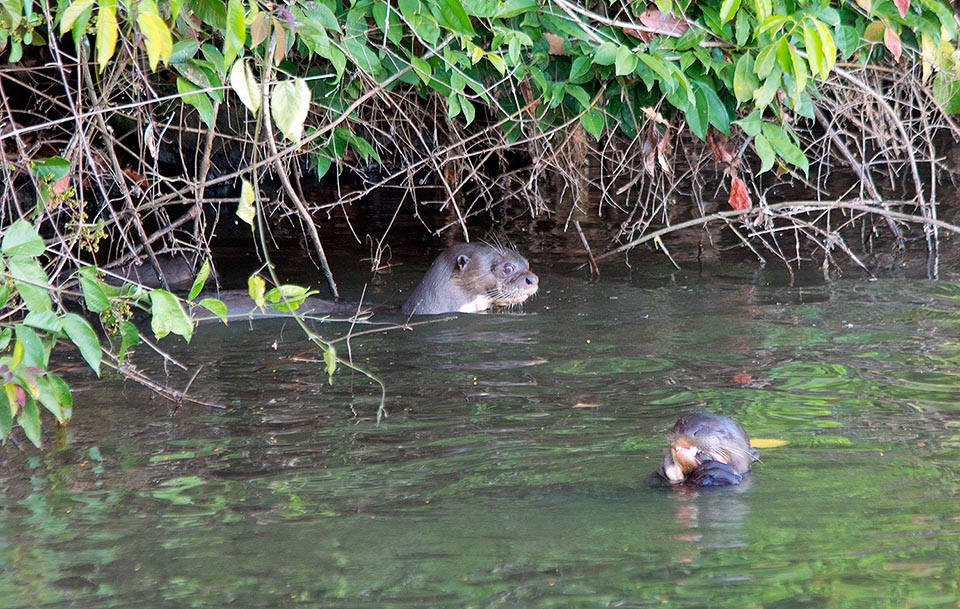
Today sadly is endangered. The few extant populations are menaced by the exploitation of the Amazon, Orinoco and Rio de la Plata rivers © Giorgio Venturini
Ecology-Habitat
Pteronura brasiliensis loves the still waters or with little current, rich of fish. Therefore, its typical habitat is that of the calm bends of the large rivers, lagoons, the relict bends (usually indicated with the Quechua word “cocha”), ponds and flooded plains. The lagoons and the relict bends, even if seemingly separated from the course of the rivers, during the flood periods connect again with them and this guarantees the change of water and an input of fish. They are therefore habitats quite rich trophically.
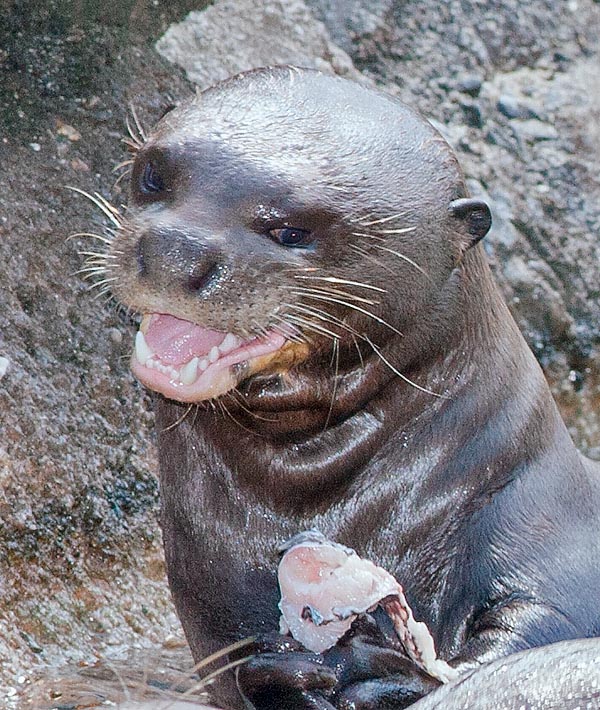
Active by day it nourishes of small caimans, anacondas but mainly of fishes © Giuseppe Mazza
It is the biggest of the four South American species of otter and is the biggest member of the family of the Mustelids (the Sea otter, Enhydra lutris, may exceed as weight the giant otter but is not equally long).
The total length of the males body stands between 1,5 and 1,8 m, in the females between 1,5 to 1,7 m. In the past they have seized specimens of even 2,20-2,40 m.
The weight in the actual specimens is of 26-32 kg for the males and of 22-26 for the females. The flexible body, the long (40-70 cm) flattened tail and the short webbed feet render it an excellent swimmer. The sexual dimorphism is almost absent, apart the slightly minor dimensions in the females.
The very thick fur is formed by guard hairs, about 8 mm long, and by an inner layer of thinner hairs (wad), is brown or fawn and appears almost black when wet.
The guard hairs hold the water and maintain the inner layer of the fur in contact with the skin dry.
The rhinarium, unlike the other species of otters, is completely covered by hair.
The head appears almost spherical thanks to the short muzzle and the round and small ears. Are present long vibrissae, important as sensors during the immersion. The nostrils, slitlike, may be closed during the immersion.
The mantle, on the chest and the throat, has some pale cream colour spots, whose pattern is specific for each individual and allows its identification. Are present anal odoriferous glands, used for marking the territory.
The set of teeth is characterized by large canines. The study of the deposition of the dentin has been utilized for estimating the longevity of this animal, calculated in about 6-10 years or little more (in captivity are reported longer survivals, up to more than 15 years. The skull has an evident sagittal crest that allows the insertion of the big muscles needed for the powerful bite.
The eyes allow a good vision under all conditions. The giant otter is in fact emmetropic or only slightly shortsighted in air as well as in water thanks to an extraordinary accommodation power of more than 50 diopters made possible by the very developed ciliary musculature that, during the immersion, acts modifying the radius of curvature of the lens (we have to consider that in the man the accommodation power is of about 5 diopters!). The animal, therefore, when in air is able to recognize an observer up to 50 m away and in immersion can hunt on sight.
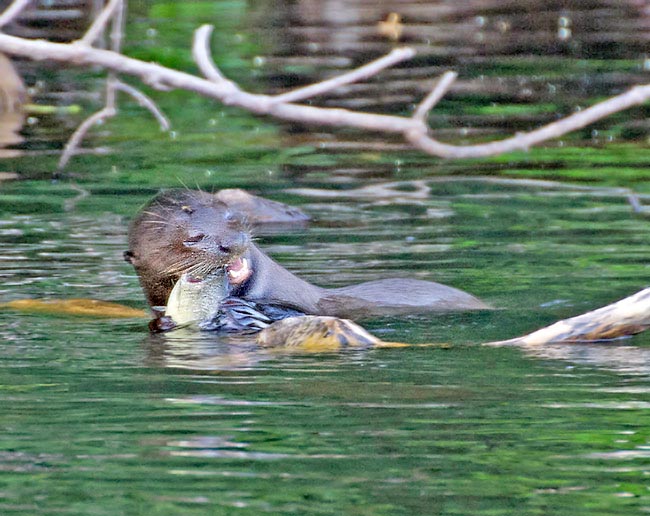
Usually the meal begins with the head of the prey. Can be big characiforms, for instance piranhas, but also smaller fishes, like cichlids, better for nourishing the progeny. Caimans are prey, predators and competitors for resources © Giorgio Venturini
The giant otter is a social animal and highly territorial, living in family groups usually of 3-8 individuals that hunt, sleep and play together. Usually, the group is formed by a couple of reproducers and by one or two litters that, as we shall see, carry on an important rôle in the economy of the group. The territory is marked with the faeces or with the secretion of the anal glands. The dimensions of the territory occupied by a group are as an average, in the case of instance of a lagoon, of about 5 square km, even if these dimensions may amply vary depending on the availability of fish.
Inside their territory the otters arrange some living areas free from vegetation, where they rest or dry up, even if often for drying themselves or rest they utilize some fallen trunks of trees emerging from the water. The young, reached the age of the reproduction, usually leave the group and move into a new environment. Only exceptionally one individual that has left the origin group has been noted joining it again, and, in such case, only on a temporary base.
The otters are diurnal animals and spend the night in dens dug in the land among the thick vegetation of the banks. Each den has usually various entrances. During the day, they devote to hunt and play, often emitting vocalizations similar to barks of growls. The hunt is usually performed in an individual way, though sometimes, in the case of big preys, such as small caimans or anacondas, there may be a cooperation among more individuals. Usually, they eat by starting from the head, holding the fish with the fore feet.
A recent study on the vocalizations emitted by the giant otter has shown the utilization of at least 22 types of sounds by the adults and 11 by the neonates. Some signals are emitted in air, others underwater. The meaning of the calls is quite varied and goes from the calls for the mating to danger signals (probably also specific for the type of danger) or of menace up to instructions to train the puppies in hunting. The pups emit, for instance, signals of request of food or signals of strain but also vocalizations that are forerunners of the adults’ ones.
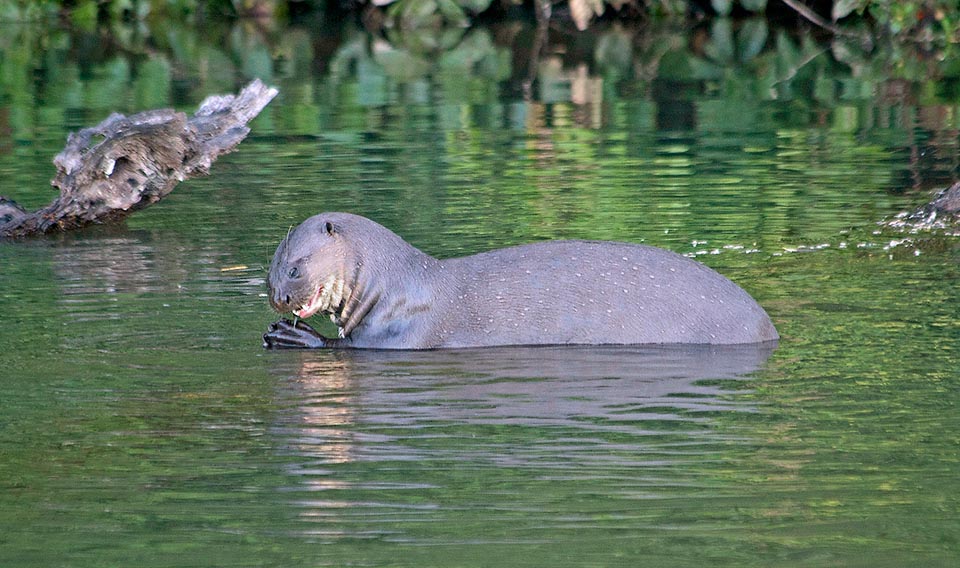
The typical habitat of Pteronura brasiliensis is the calm bends of the great rivers, lagoons, ponds and flooded plains © Giorgio Venturini
The giant otter eats mainly fishes. An adult specimen eats usually 3-4 kg of fish by day and this renders necessary waters extremely rich. The study of the feces and the direct observation show that besides fishes, even if in lesser quantity, they predate also crustaceans, small mammals, bird and reptilians like caimans or snakes. Among the fishes the most frequently predated are cichlids and characiforms but the preferences vary depending on the habitat. Some studies have shown that the choice of the preys is also motivated by the presence or not of pups in the group. When the pups are present the hunting is mainly oriented towards small cichlids, easy to utilize and chew by the puppies and especially abundant and easy to catch close to the nests, thing that avoids long absence of the parents and consequently the risk of attacks by the caimans.
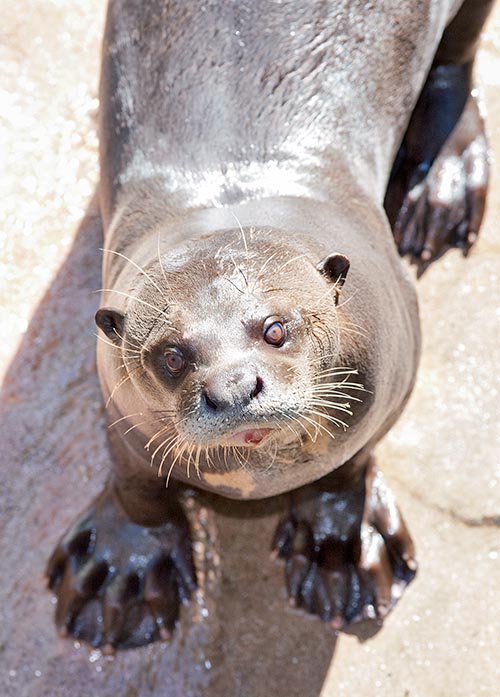
The males may exceed the 2 m with a weight of 30 kg. The webbed feet, flexible body and long flat tail allow skillful twirls. The sexual dimorphism is almost absent © Mazza
Except the man, the giant otter does not have important natural foes. There may happen aggressions by big felines such as the jaguar or by reptilians such as caimans or anacondas but these events are not frequent. Have been observed instances where some pecaris (Suids) have destroyed nests and devoured the young. A source of danger stands in the electric eels or in the poisonous stingrays (Chondrichthyans Myliobatiformes) that can cause even fatal in juries.
The knowledge we have about the reproduction are based mainly on the observation of animals in captivity. The otter is sexually mature when two years old, the oestral cycle lasts 21 days as an average and the cycles occur all over the year. The females are receptive for 3-10 day in every cycle and in this period they are more aggressive and less prone to hunting and playing and furthermore nipples and vulva appear swollen.
The mating takes place in water and, after 50-70 days of gestation are birthed one to five pups (two as an average), with a survival of less than the 30%. In the wild the fertility peak occurs between January and April. At birth the pups weigh about 200 grams and are about 30 cm long; when one month old they open their eyes and can swim, when 3-4 months old they follow the adults in the movements and begin to hunt. When 9-10 months old they cannot practically be distinguished from the adults.
Among the extant 13 species of otters, the giant otter is the only one showing a behaviour of cooperative breeding of the pups, with the young of the previous years (helpers) helping the parents in breeding the pups of the last generation.
Studies performed on free otters have shown that the helpers cooperate really in an efficient way to the breeding, increasing the survival probabilities of the pups, even if the reproducing pair may breed effectively the progeny without the intervention of the helpers. Furthermore, the membres of the family differ between them in the quantity of help given and the availability to collaborate increases with the age.
As we have seen, the young reach the reproductive age around the 2 years, but may remain into the native family, thus collaborating in the breeding of the pups for 1,5-4 years more before getting away. The individuals that go away will be able then to live moving among the various territories (floaters), at times along with other membres that have left the same family or at times with individuals not related. Usually, by the death of the reproducing pair one of the females will inherit the territory mating then with a male coming from outside.
The cares and the providing food to the oldest and weakest membres of the family are usually considered as typical to the man and only in andeptic way are described in the other animals.
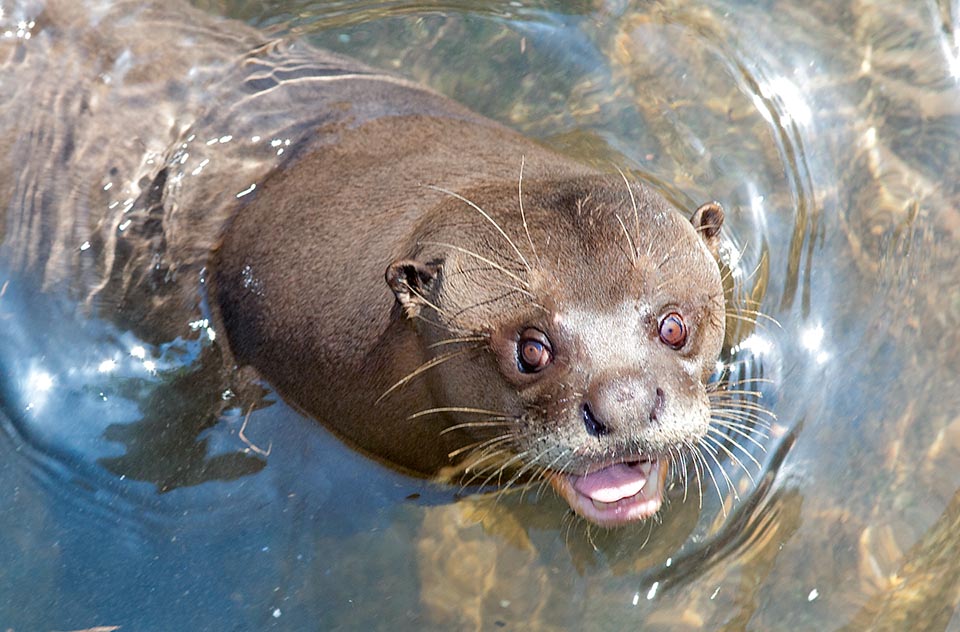
Emmetropic or only slightly shortsighted, the giant otter has an accommodation power of more than 50 dioptres due to the very developped ciliar muscles that may modify the lens curvature radius. So, it sees well immersed and out distinctly at 50 m far. The long vibrissae are important sensors in torbid waters © Giuseppe Mazza
In the case of the giant otter the phenomenon has been observed and described precisely. In a family living in a cocha in Manu Peruvian park (Madre de Dios) it has been proved an evident case of reversal of roles for a female that, until the age of 11 had been the reproducer and had furnished food to the young: after the 11 years has met a physical decay, has ceased to reproduce and has begun to ask and get regularly food from its partner and from 3 of the 4 sons.
This help from the membres of the family might be explained on the basis of a non adaptive hypothesis as well as of an adaptive one. That is, it could be given without any expectancy of future reward, or as simple redirecting of a help normally given to the pups, or as the expectation that the old female may still furnish some benefits to the group, for instance in caring the youngest (it’s the“Grandmother hypothesis”) of the adaptive menopause in the human species and in other ones, suggested for the first time in 1957 by the evolutionary biologist G.C. Williams).
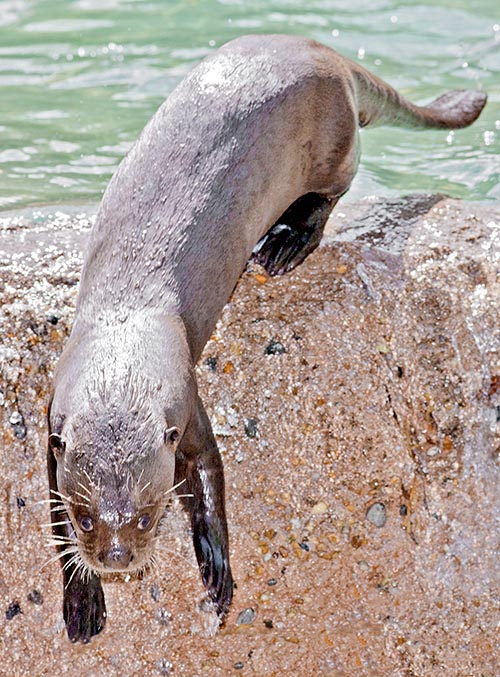
Pteronura brasiliensis hunts alone or in group, if the preys are big. The small and joyous communities worry also for the old individuals often fed like the pups © Giuseppe Mazza
Risks for the survival of the species
Before the beginning of the large-scale human settlements in the Amazonian basin the main danger for the survival of the Giant otter stood in the fur hunters. Nowadays, with the hunting ban, the surviving populations are facing different dangers.
Colonization and deforestation
The development and the human colonization of the tropical forests has rendered many areas no more suitable for bearing the survival of the populations of Pteronura. Moreover, whilst traditionally the rivers have represented the most important penetration ways in the South-American forests, the construction of several lorry roads has opened to the human penetration areas which were previously inaccessible. The increment of the human settlements causes also a greater exploitation of the fish resources and consequently a reduction in the food sources for the otter. Further, considering that the soils poor of nutrients of the Amazonia, once deforested they can sustain cultivations and breedings for not more than 5-10 years, the outlook is that of a continuous increase of the deforestation, in absence of important intervention of environmental protection.
Hydroelectric exploitation
The construction of dams and the flooding of ample areas of forests make accessible to the man ever greater areas. The dams furthermore represent a hindrance to the migratory ways of the fishes and modify the quality of the waters, with dramatic consequences for the otters. Moreover, often in the newly formed basins are introduced allochthonous fish-species that can become competitors for the otter.
Mining activities
One of the worst threats for the survival of the giant otter is represented by the mining activity of the gold extraction. In many zones of the Amazonian basin are present in large number legal or illegal miners that practice the draining of the gravel and of the sand of the rivers, with consequent increase of the particles suspended in the water, as interferring with the light penetration, causes damages to the weeds and chokes the fishes. The most serious damage is however due to the use of mercury to amalgamate and extract the particles of gold from the sand. For every kilo of gold extracted are poured in the environment 1 to 4 kg of mercury. The metal in the Amazonian rivers, reacts with the organic substances and inserts in the food chain cumulating then in the tissues of the predating fishes and finally of the otter, with toxic and dramatic effects.
Fossil fuels extraction
Oil or gas fields ae exploited in various zones of the Amazon and Orinico basins, even in protected areas such as the Yasuni National Park or the Cuyabeno Wildlife Reserve in Ecuador. The environmental damages come from the construction of roads linked to the exploration or the exploitation, the deforestation and the human settlements and especially to the oil spills that contaminate the waters and the residual sludge from drillings. In Ecuador leaks in a pipeline have caused the overflow of tens of million of litres of oil in the waters.
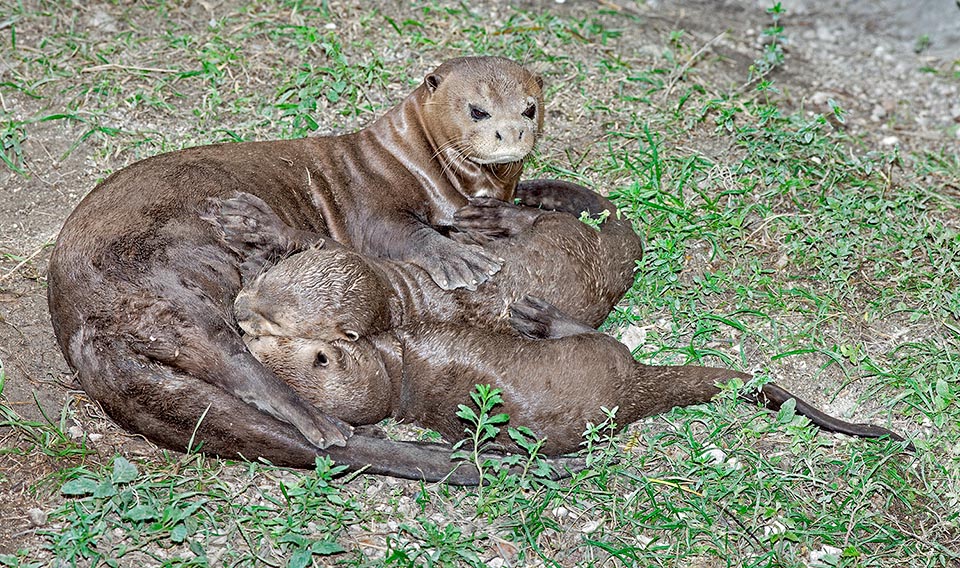
Female milking the pups. Besides parents often various membres of the group care the pups that well nourished when 9-10 months old have already the adult size © Giuseppe Mazza
More recently a new threat for the survival of the otters comes from the irresponsible tourism , with groups of tourists who, on board of boats, try to get too close to the otters, causing them a stress that may get to induce the parents to abandon the den and the progeny.
The native human populations of the tropical Spouth American fluvial regions have lived for centuries together with the giant otter without any particular problem. The not palatable meat and the lack of interest for the furs have spared this mustelid from the activities of the native hunters. In some cases human groups that sustain with fishing have seen in the otter a competitor to eliminate, but these are isolated cases. In some villages there is the custom to catch the young of the otter as company animals for the children but the impact of these habits is negligible.
Remarkable is also the role of the giant otter in the mythology of various Amazonian populations, where often the otters are considered as spirits of the waters or even transformed men due to magical intervention.
→ To appreciate the biodiversity within MUSTELIDAE please click here.
